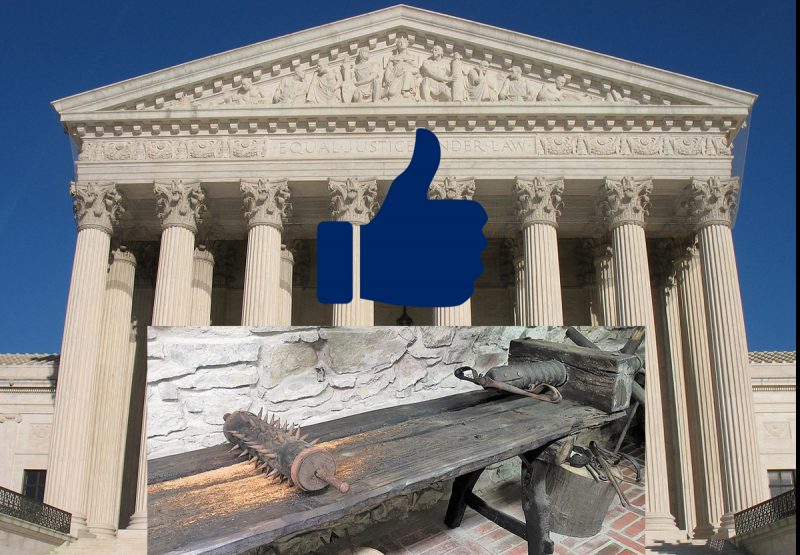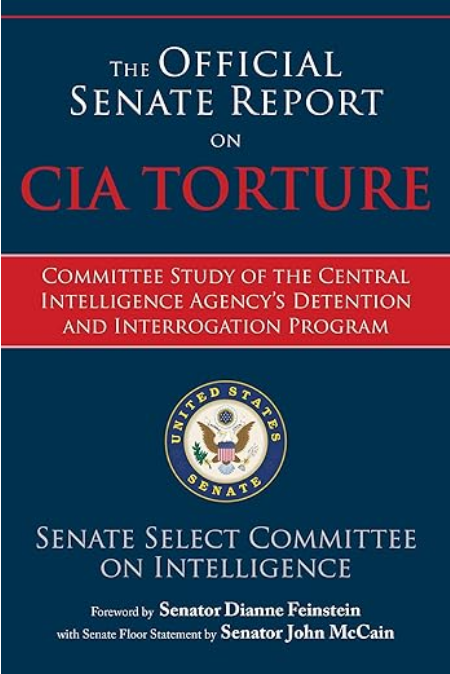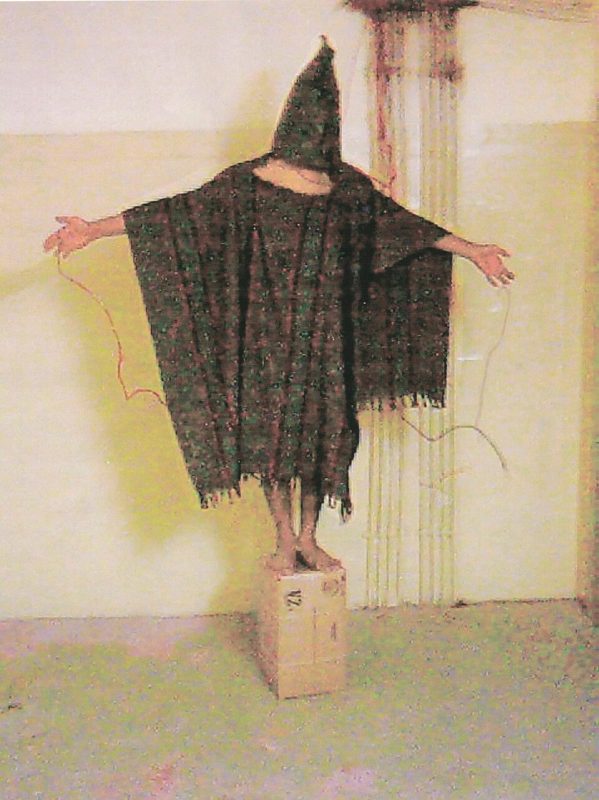The Good Intentions License for Tyranny
by James Bovard
“He who saves his country violates no law,” tweeted President Trump in February. He was echoing a line often attributed to Napoleon Bonaparte. His supporters were electrified by Trump’s tacit invocation of a right to boundless power.
The Trump presidency is already spurring legal battles across the nation. It is far too soon to speculate on Trump’s final win/loss record in federal courts. But Americans should be aware of how the entire judicial process is skewed against holding officialdom liable for its crimes.
Whitewashing torture
The most stunning example of federal impunity is the whitewashing of the Bush administration torture scandal. President George W. Bush unleashed a worldwide torture regime that left victims dead and maimed around the globe. But federal officials and federal judges made sure that not a single torture policymaker or CIA torturer faced any penalty for their barbarity.
Torture policymakers seemed to recognize only one possible adverse consequence from getting rough with their targets. “If the detainee dies, you’re doing it wrong,” wrote Jonathan Fredman, the top lawyer for the CIA Counterterrorist Center in 2002. A congressional hearing in June 2008 revealed that “C.I.A. lawyers believed they had found a legal loophole permitting the agency to use ‘cruel, inhuman or degrading’ methods overseas as long as they did not amount to torture,” the New York Times reported. Fredman warned other federal lawyers involved with sanctifying the interrogation regime: “If someone dies while aggressive techniques are being used, regardless of cause of death, the backlash of attention would be severely detrimental.”
The official attitude toward killing detainees was stark early on in the case of Gul Rahman. He was captured by U.S. agents in October 2002 and was suspected of being a militant. The CIA subjected Rahman to “48 hours of sleep deprivation, auditory overload, total darkness, isolation, a cold shower and rough treatment.” Rahman died in November 2002 after effectively freezing to death “after being stripped naked from the waist down and shackled to a cold cement wall in the Salt Pit, where temperatures were approximately 36°F.” Rather than face prosecution for killing Rahman, the primary CIA interrogator was recommended for a $2,500 cash award for his “consistently superior work,” according to a 2014 Senate report.
For government officials, the decisive legal question is not what federal law prohibits but what behavior will be punished. What happens when feds violate the law of the land?
Whitewashing torture
Today’s legal system allows presumed good intentions to almost always exonerate the worst abuses by government officials. As long as they deny criminal intent, they will almost always be absolved by their fellow government employees.
The Intentions Test for government officials becomes almost a tautology. People work for the government because they want to help other people. Therefore, when some government official violated some legal technicality, did he intend to do something bad?
The Bush administration exploited this presumption to argue in secret memos that U.S. government agents could not be found guilty of torture regardless of their conduct. Bush-appointed lawyers showed how easily even the most aggressive interrogators could be free of a torturous intent:
“Because Section 2340 [of the federal Anti-Torture Act] requires that a defendant act with the specific intent to inflict severe pain, the infliction of such pain must be the defendant’s precise objective. If the defendant acted knowing that severe pain or suffering was reasonably likely to result from his actions, but no more, he would have acted only with general intent. As a theoretical matter, therefore, knowledge alone that a particular result is certain to occur does not constitute specific intent…. Thus, even if the defendant knows that severe pain will result from his actions, if causing such harm is not his objective, he lacks the requisite specific intent even though the defendant did not act in good faith.’
The memo offered the following illustration: “In the context of mail fraud, if an individual honestly believes that the material transmitted is truthful, he has not acted with the required intent to deceive or mislead.” Mailing brochures on bogus cholesterol cures helped set the standard for government employees who maimed detainees who did not confess quickly enough. The memo assured would-be torturers and torture supervisors: “A good faith belief need not be a reasonable one.”
Good-faith torture
Such legal reasoning spawned a world-wide epidemic of “good-faith torture.”
The Justice Department memo recited the damage of 9/11 in order to justify the presumption that torture would prevent similar carnage: “Given the massive destruction and loss of life caused by the September 11 attacks, it is reasonable to believe that information gained from al Qaeda personnel could prevent attacks of a similar (if not greater) magnitude from occurring in the United States.” But a 6,000-page Senate Intelligence Committee report finally released in 2014 concluded that the torture failed to produce any information that prevented terror attacks or saved American lives.
In one of the most stunning assertions, the Justice Department stressed that even intentionally killing people during an interrogation might be okay: “The necessity defense may prove especially relevant in the current circumstances. First, the defense is not limited to certain types of harms. Therefore, the harm inflicted by necessity may include intentional homicide, so long as the harm avoided is greater (i.e., preventing more deaths).
“Second, it must actually be the defendant’s intention to avoid the greater harm….
“Third, if the defendant reasonably believed that the lesser harm was necessary, even if, unknown to him, it was not, he may still avail himself of the defense….
“Clearly, any harm that might occur during an interrogation would pale to insignificance compared to the harm avoided by preventing such an attack, which could take hundreds or thousands of lives.
 The Justice Department preemptively exonerated U.S. government officials who violate the Anti-Torture Act: “If a government defendant were to harm an enemy combatant during an interrogation in a manner that might arguably violate Section 2340A, he would be doing so in order to prevent further attacks on the United States by the al Qaeda terrorist network.” The Justice Department did not explain why preventing a catastrophic attack is the only reason why a suspect might be maimed during interrogation.
The Justice Department preemptively exonerated U.S. government officials who violate the Anti-Torture Act: “If a government defendant were to harm an enemy combatant during an interrogation in a manner that might arguably violate Section 2340A, he would be doing so in order to prevent further attacks on the United States by the al Qaeda terrorist network.” The Justice Department did not explain why preventing a catastrophic attack is the only reason why a suspect might be maimed during interrogation.
The memo sanctified boundless power by stressing the uniqueness of the post–9/11 world: “The situation in which these issues arise is unprecedented in recent American history…. [These] attacks aimed at critical Government buildings in the nation’s capital and landmark buildings in its financial center.” But President James Madison did not announce that the U.S. government was obliged to start torturing people after the British burned down Washington in 1814.
After the Abu Ghraib photos became public, Bush continually stressed America’s good intentions as proof that the U.S. government did not torture. On June 22, 2004, Bush responded to criticism: “Let me make very clear the position of my government and our country…. The values of this country are such that torture is not a part of our soul and our being.” Bush continually recited his praise about American values whenever he was challenged about the torture he authorized.
Justifying torture
In late 2005, 18 months after leaked memos revealed the Bush administration’s belief that the Anti-Torture Act was null, Congress passed the Detainee Treatment Act, which prohibited the use of “cruel, inhumane, or degrading” interrogation methods. Top Justice Department officials responded to the new law with a secret internal memo declaring that all the interrogation methods currently being used — head slapping, waterboarding, frigid temperatures, and blasting with loud music to assure sleep deprivation — were not “cruel, inhumane or degrading.” The secret torture memos, written by assistant attorney general Steven Bradbury, relied on “a Supreme Court finding that only conduct that ‘shocks the conscience’” would go too far.
 Other administration officials used the same standard to exonerate themselves. Vice President Dick Cheney, who largely dictated the Bush policy, was asked in a television interview, “What’s the president’s prerogative in the cruel treatment of prisoners?” Cheney invoked the “shocks the conscience” standard, and then mentioned that “what shocks the conscience” is to some extent “in the eye of the beholder.” This standard leaves it up to government officials to decide whether they are personally offended about how they are using their power. If a policy does not shock a politicians’ conscience, it must be okay.
Other administration officials used the same standard to exonerate themselves. Vice President Dick Cheney, who largely dictated the Bush policy, was asked in a television interview, “What’s the president’s prerogative in the cruel treatment of prisoners?” Cheney invoked the “shocks the conscience” standard, and then mentioned that “what shocks the conscience” is to some extent “in the eye of the beholder.” This standard leaves it up to government officials to decide whether they are personally offended about how they are using their power. If a policy does not shock a politicians’ conscience, it must be okay.
The “shock the conscience” test becomes a slippery slope. The more abuses government commits, the more numb people become. What would have been condemned one year evokes shrugs and yawns a few years later. This becomes Barbarism on the Installment Plan. Cheney publicly declared his approval for simulated drowning of detainees, even though the U.S. government had considered this a war crime for over a century.
In 2007, the New York Times detailed how, after 9/11, the CIA constructed an interrogation program by “consulting Egyptian and Saudi intelligence officials and copying Soviet interrogation methods long used in training American servicemen to withstand capture.” For decades, the U.S. government condemned Soviet, Egyptian, and Saudi torture. But interrogation systems designed to compel victims to sign false confessions supposedly provided the model for protecting America in the new millennium.
In a July 2007 executive order, Bush offered a “good intention” definition of torture. Bush stressed that interrogators are prohibited from “intentionally causing serious bodily injury” and “acts intended to denigrate the religion, religious practices, or religious objects of the individual.” Bush banned “willful and outrageous acts of personal abuse done for the purpose of humiliating or degrading the individual in a manner so serious that any reasonable person … would deem the acts to be beyond the bounds of human decency, such as sexual or sexually indecent acts undertaken for the purpose of humiliation.”
 Former Marine Corps Commandant Paul X. Kelley condemned the new guidelines for encouraging abuses: “As long as the intent of the abuse is to gather intelligence or to prevent future attacks, and the abuse is not ‘done for the purpose of humiliating or degrading the individual’ — even if that is an inevitable consequence — the president has given the CIA carte blanche to engage in ‘willful and outrageous acts of personal abuse.’” Georgetown University law professor David Cole noted that Bush’s order “appears to permit cutting or bruising a suspect so long as the injury does not risk death, significant functional impairment or ‘extreme physical pain,’ an entirely subjective term.” The key portion of the executive order — the list of approved interrogation techniques — was kept secret. Tom Malinowski of Human Rights Watch observed, “All the order really does is to have the president say, ‘Everything in that other document that I’m not showing you is legal — trust me.’”
Former Marine Corps Commandant Paul X. Kelley condemned the new guidelines for encouraging abuses: “As long as the intent of the abuse is to gather intelligence or to prevent future attacks, and the abuse is not ‘done for the purpose of humiliating or degrading the individual’ — even if that is an inevitable consequence — the president has given the CIA carte blanche to engage in ‘willful and outrageous acts of personal abuse.’” Georgetown University law professor David Cole noted that Bush’s order “appears to permit cutting or bruising a suspect so long as the injury does not risk death, significant functional impairment or ‘extreme physical pain,’ an entirely subjective term.” The key portion of the executive order — the list of approved interrogation techniques — was kept secret. Tom Malinowski of Human Rights Watch observed, “All the order really does is to have the president say, ‘Everything in that other document that I’m not showing you is legal — trust me.’”
Thanks to this legal framework, none of the deaths that occurred during interrogations by U.S. government agents were homicides. Instead, they were simply accidents, regardless of how much force was used or how many bones were broken. The CIA made tapes of its vigorous interrogations but destroyed them, even though a federal court had ordered their preservation. Attorney General Michael Mukasey refused to appoint a special counsel to investigate possible crimes because “certifications were given” by the Justice Department which absolved the CIA agents “who permissibly relied on it.” Sen. Sheldon Whitehouse (D-RI) derided this position “as the Nuremberg defense…. I had authorization and therefore I’m immune from prosecution.”
But the Bush torture policymakers got away with their crimes — thanks in part to President Obama betraying a campaign promise and issuing a blanket exoneration for interrogation abuses.
A license for tyranny
 reedom cannot survive such impunity. The government uses strict liability to judge companies and industries that deal with hazardous substances. With this standard, an individual can be found liable even without proof of negligence or reckless behavior. The more force a government official uses, the more he should be judged by a strict liability standard.
reedom cannot survive such impunity. The government uses strict liability to judge companies and industries that deal with hazardous substances. With this standard, an individual can be found liable even without proof of negligence or reckless behavior. The more force a government official uses, the more he should be judged by a strict liability standard.
The more power a person seeks, the less credit his unverifiable intentions deserve. Politicians and the media encourage people to judge rulers by the same standard used for aunts and uncles. But good intentions are far more dispositive in private life than in political life. This is especially true of high-ranking government officials, who almost always avoid vigorous courtroom and congressional examinations of their conduct — much less depositions.
“Meant well” is sufficient apology for bone-headed birthday presents but not for the destruction of rights and liberties. The Founding Fathers crafted the Constitution to protect Americans against politicians who claimed good intentions. Nothing has happened in the subsequent centuries to justify giving any politician a good intention license for tyranny.
James Bovard is a policy advisor to The Future of Freedom Foundation and is the author of the ebook Freedom Frauds: Hard Lessons in American Liberty, published by FFF, his new book, Last Rights: The Death of American Liberty, and nine other books.



Comments are closed.